[swarthmore cs75] Compiler 1 – Adder
课程回顾
Swarthmore学院16年开的编译系统课,总共10次大作业。本随笔记录了相关的课堂笔记以及第3次大作业。
- 编译的过程:首先解析(parse)源代码,然后成抽象语法树(AST),再生成汇编代码(asm),最后用asm生成的目标文件(object)和其他库文件链接成一个可执行的二进制文件(binary)。其中从抽象语法树到生成汇编代码这个过程(complier.ml)工作量最大。
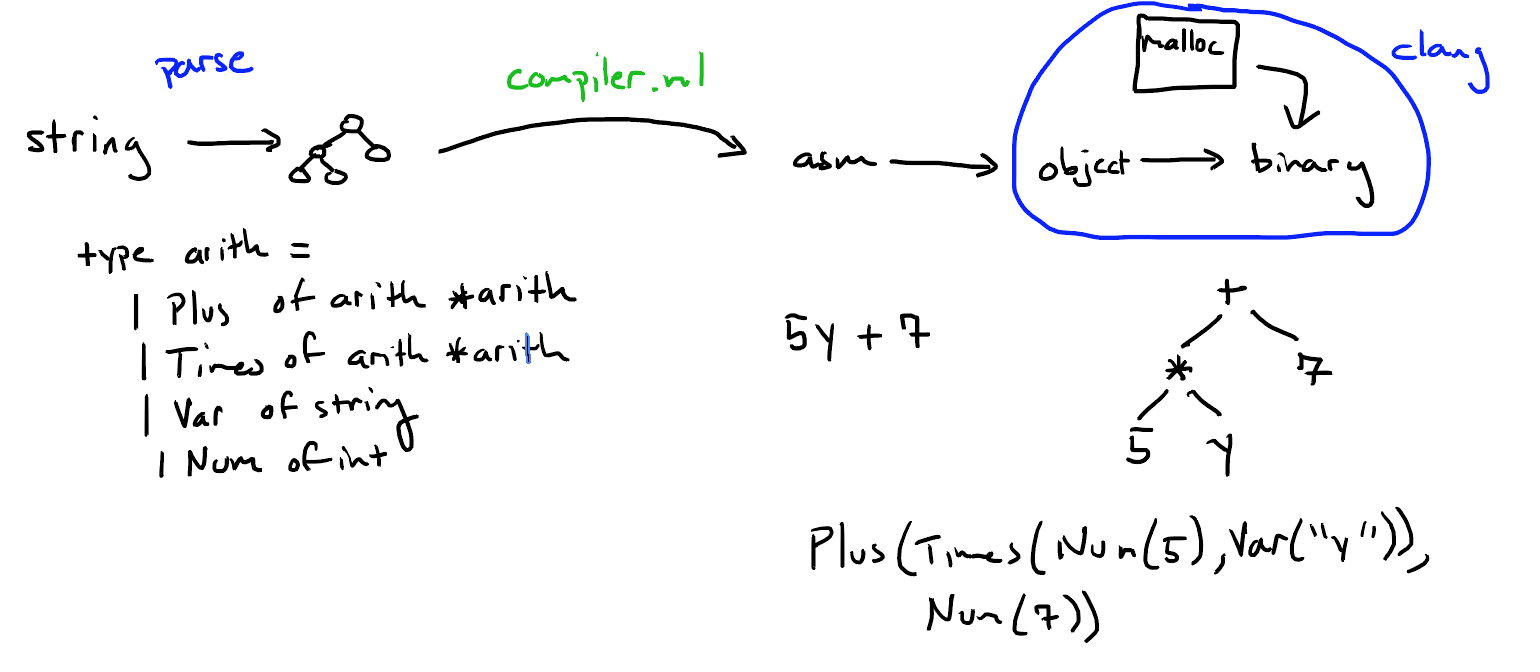
- 具体语法树(Concrete Syntax Tree):programmer写的就是具体语法,下图展示了某具体语法形象的表示。
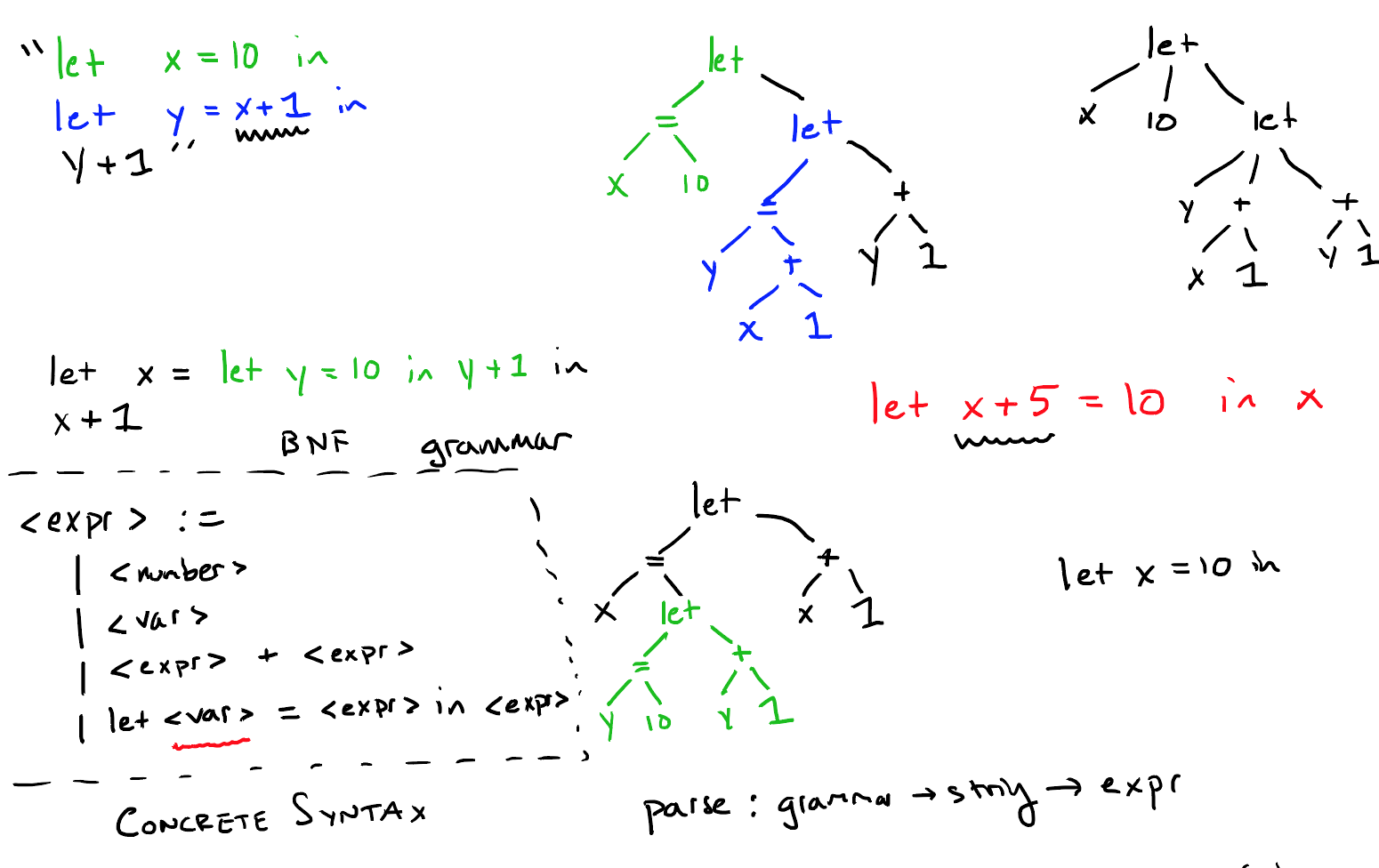
- 抽象语法树(Abstract Syntax Tree):一段具体语法,应该在内存中用何种数据结构来表示。所以根据具体语法的定义,有了抽象语法的概念。比如:let x=6, y=add1(x) in y; 在内存中可以表示为 Let([(x, 6), (Prim1(add1, Id("x")))], Id("y"))
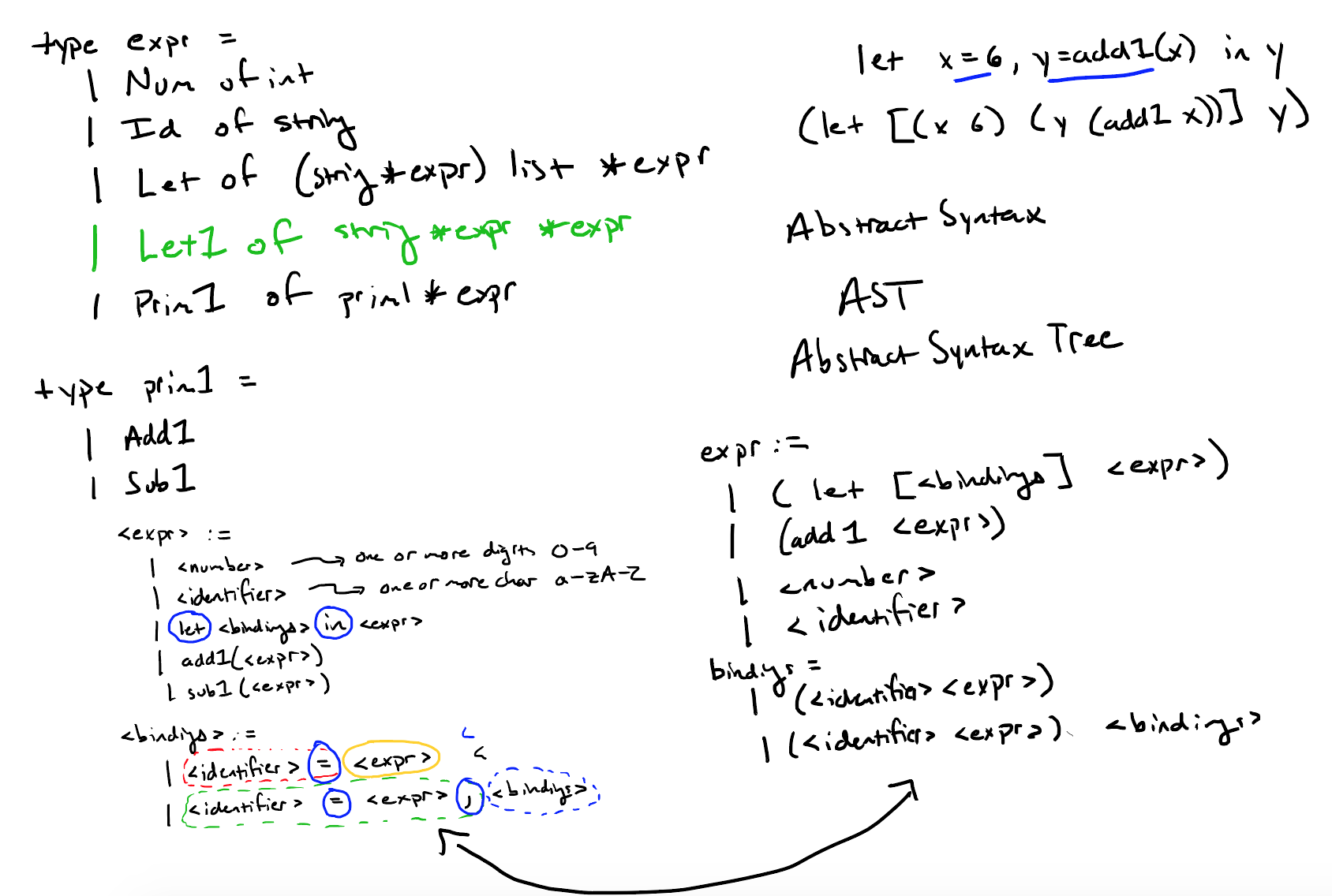
- 汇编代码生成(Add1、Sub1):
- Add1:需要将操作数mov到eax寄存器,然后把eax加1即可,这里操作数可能是一个表达式的计算结果,所以需要递归求值。
- Sub1:同理

- 汇编代码生成(Let、Id):
- Id:检查当前env是否绑定了某变量的地址,如果绑定了,把操作数(esp[地址偏移量])移动到eax寄存器,否则抛出错误。
- Let:为了简化问题,假设let中的binding list只有一个元素,比如要计算:let ex in eb;首先要对ex=(x, value)中的value进行递归求值(参数使用env和si);然后为x绑定一个新地:-4 * si,添加到new_env中,并对eb进行递归求值(参数使用new_env并将si+1)。最后将两个递归所生成的指令拼接到一起。
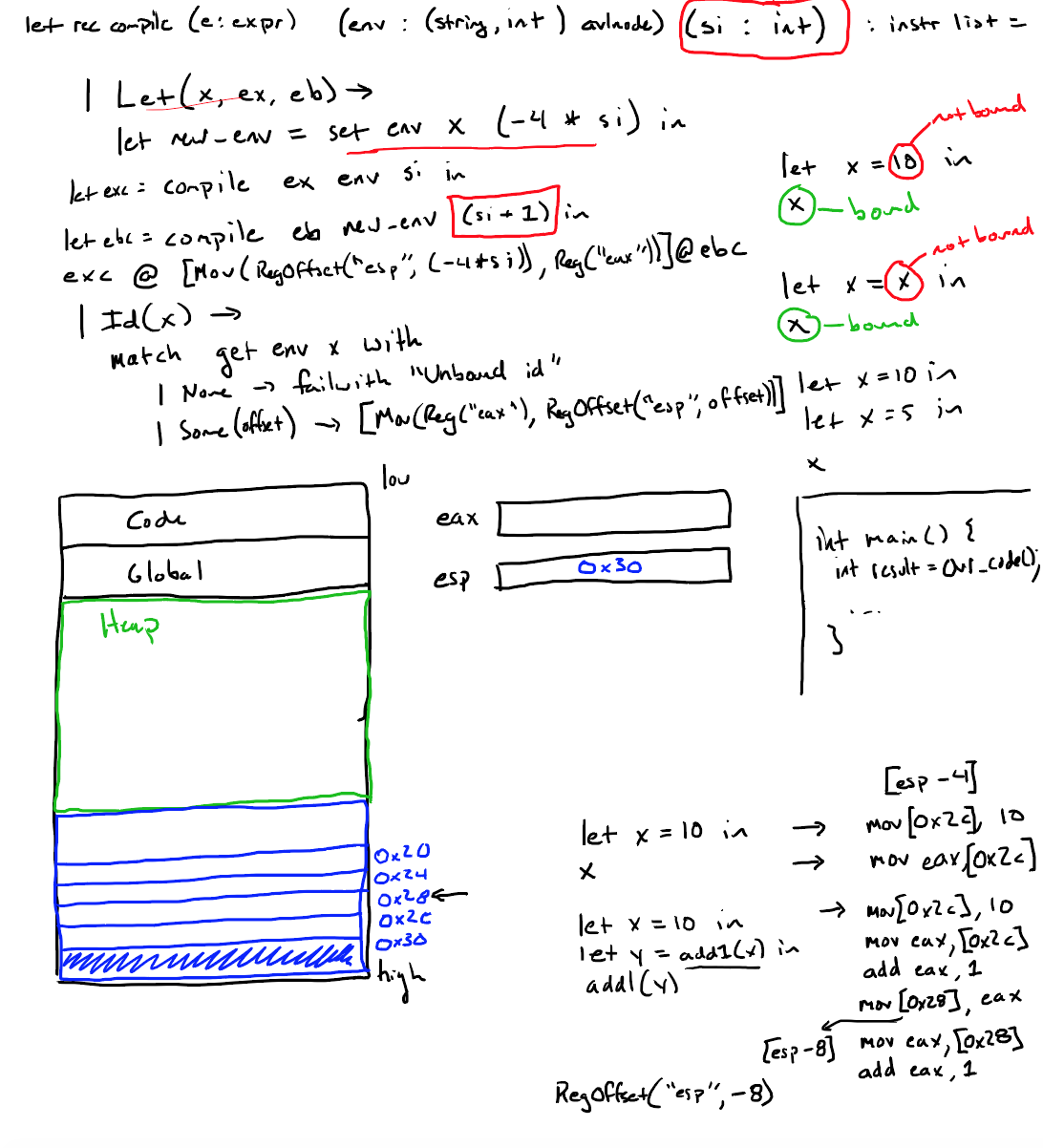
- 汇编代码生成(案例):注意下图第一个例子在对x进行赋值操作的时候,变量x并没有使用一个新的地址:esp-8,而是重复利用了变量y的地址:esp-4。因为变量y在外部无法引用。
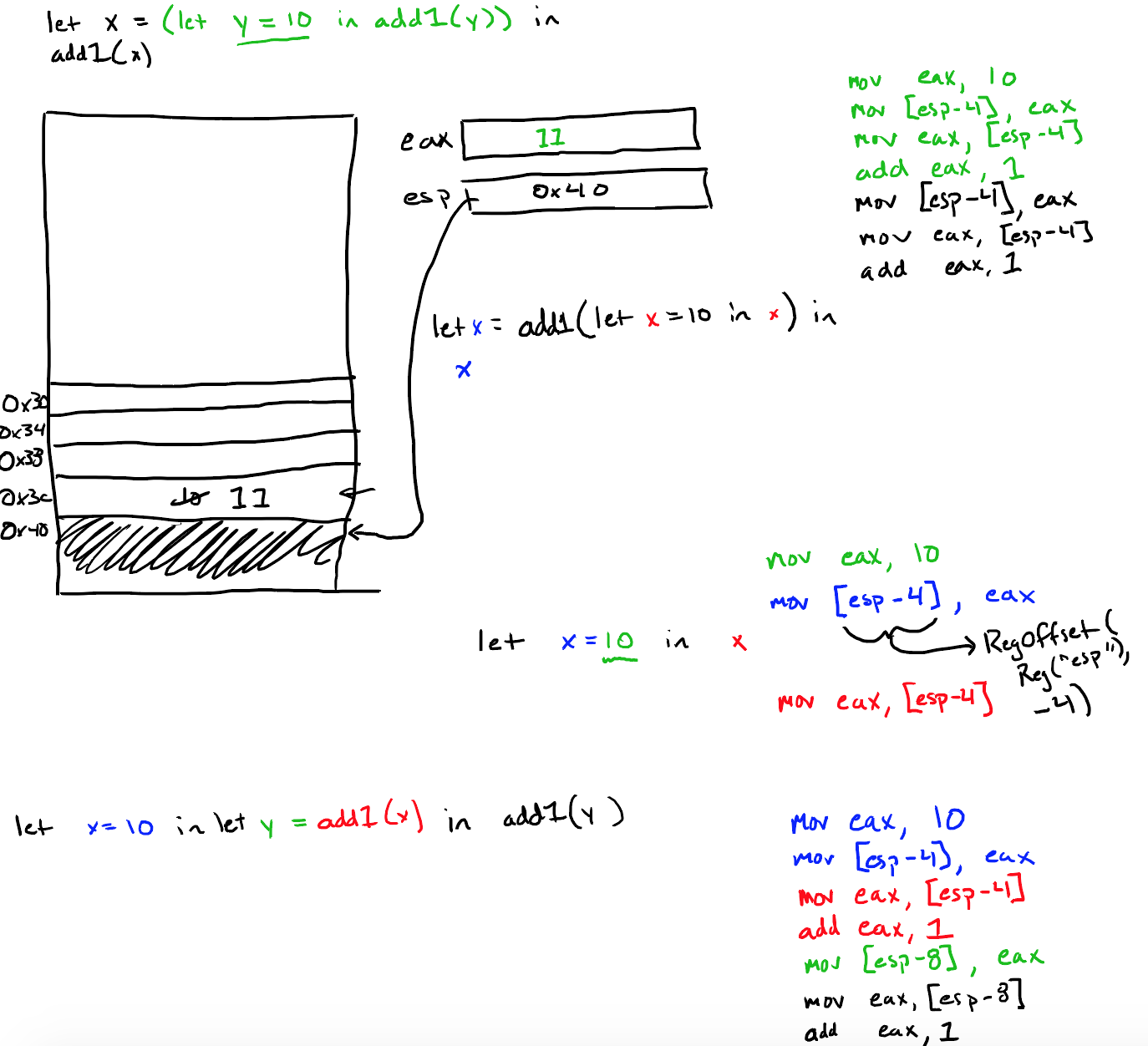
编程作业
本次大作业是为Adder编程语言实现一个小型编译器,将Adder程序编译为X86_32汇编。
-
具体语法:
<expr> := | <number> | <identifier> | let <bindings> in <expr> | add1(<expr>) | sub1(<expr>) <bindings> := | <identifier> = <expr> | <identifier> = <expr>, <bindings> -
抽象语法:
type prim1 = | Add1 | Sub1 type expr = | Number of int | Prim1 of prim1 * expr | Let of (string * expr) list * expr | Id of string -
程序例子:
Concrete Syntax Abstract Syntax Answer 5 Number(5) 5 let x=(let y=10 in y) in x Let(["x", Let(["y", 10], Id("y"))], Id("x")) 10 let x=100 in let x=1 in x Let(["x", Number(100), Let(["x", 1], Id("x"))]) 1 let x = 5 in add1(x) Let([("x", Number(5))], Prim1(Add1, Id("x"))) 6 let x=1 in let y=add1(x) in y Let(["x", 1], Let(["y", Prim1(Add1, Id("x"))], Id("y"))) 2 sub1(add1(sub1(5))) Prim1(Sub1, Prim1(Add1, Prim1(Sub1, Number(5)))) 4 let x=10 in let y=add1(x) in add1(y) Let(["x", 10], Let(["y", Prime1(Add1, Id("x"))], Prime1(Add1, Id("y")))) 12 let x = 5, y = sub1(x) in sub1(y) Let([("x", Number(5)), ("y", Prim1(Sub1, Id("x")))], Prim1(Sub1, Id("y"))) 3 let x=1 in let x=add1(let x=6 in add1(x)) in x Let(["x", 1], Let(["x", Prim1(Add1, Let(["x", 6], Prim1(Add1, Id("x"))))], Id("x"))) 8 let y=sub1(add1(sub1(let x=5 in x))) in add1(add1(add1(y))) Let(["y", Prim1(Sub1, Prim1(Add1, Prim1(Sub1, Let(["x", Number(5)], Id("x")))))], Prim1(Add1, Prim1(Add1, Prim1(Add1, Id("y"))))) 7
| let x=1 in y|
-
|An identifier is unbound (there is no surrounding let binding for y)|| let x=10, y=20, x=5, y=30, x=40 in x|
-
|There is a binding list containing two or more bindings with the same name|-
实现一(Let使用尾递归):
分别实现Let、Id、Prim1的代码生成逻辑。因为Adder语法规定,不允许在一个binding list绑定两个相同的变量,所以这里简单的实现了一个has_unique_key方法,判断binding list的长度和去重后的长度是否相同。let rec compile_env (p : expr) (stack_index : int) (env : (string * int) list) : instruction list = match p with | Number(n) -> [ IMov(Reg(EAX), Const(n)) ] | Let(binds, body) -> let rec helper xs si env = match xs with | [] -> compile_env body (si + 1) env | (id, expr)::rest -> let new_env = (id, (-4) * si)::env in (compile_env expr si env) @ [IMov(RegOffset((-4) * si, ESP), Reg(EAX))] @ helper rest (si + 1) new_env in if has_unique_key binds then helper binds stack_index env else failwith "There is a binding list containing two or more bindings with the same name." | Id(x) -> [ match (find env x) with | Some(n) -> IMov(Reg(EAX), RegOffset(n, ESP)) | None -> failwith ("An identifier is unbound (there is no surrounding let binding for " ^ x ^ " )") ] | Prim1(op, e) -> match op with | Add1 -> (compile_env e stack_index env) @ [IAdd(Reg(EAX), Const(1))] | Sub1 -> (compile_env e stack_index env) @ [ISub(Reg(EAX), Const(1))] -
实现二(Let使用迭代):
本实现仅改写了Let的模式匹配逻辑,其他类型的pattern mathcing和上述代码一样。let new_env = List.mapi (fun si (x, _) -> x, (-4) * (stack_index + si)) binds @ env in let f si (_, e) -> (compile_env e stack_index new_env) @ [IMov(RegOffset((-4) * (stack_index + si), ESP), Reg(EAX))] in let exc = List.flatten (List.mapi f binds) in let exb = compile_env body (stack_index + 1) (new_env) in exc @ exb有一个地方需要注意一下,比如在对表达式:
let x=10, y=sub1(x) in y
进行求值的时候,会执行上述代码并会返回:
new_env = [("x", -4); ("y", -8)]
exc = List.flatten (List.mapi f [("x", Number(10)), ("y", Prim1(Sub1, Id("x")))])在函数f中,使用的是new_env作为compile_env递归调用的参数。实际上:
- 在计算Number(10)的时候,compile_env只需要传入env,而不是 [("x", -4); ("y", -8)] @ env
- 在计算Prim1(Sub1, Id("x")))的时候,compile_env只需要传入("x", -4)::env,而不是 [("x", -4); ("y", -8)] @ env
- ...以此类推。
因为Adder语言不支持binding list出现重名的变量,所以这里直接传入new_env不会出现问题。当然要是改进可以用切片操作或使用实现一中的尾递归,这里就不详述了。
-
测试时可能出现的错误:
Error: This expression has type bytes but an expression was expected of type string
⤇ export OCAMLPARAM="safe-string=0,_"





